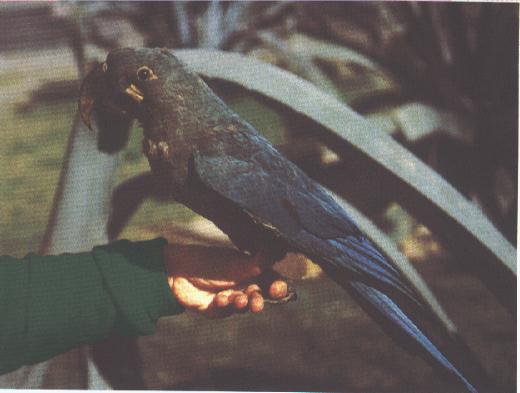Macaw - Glaucous
Blue Macaw Scientific Name: Anodorhynchus glaucus
Fri, 1st November, 2024 - 2:34 am GMT
Sponsor Ads:

Alternative Name
Blue Macaw Scientific Name: Anodorhynchus glaucusBasic Info
The Glaucous Macaw was often mistaken for Lear's Macaw due to a similar size and build, but the Glaucous or Blue Macaw had different coloration. Its feathers were blue, and could change hues in different types of lighting! Generally, the Glaucous Macaw's plumage was a brilliant greenish-blue. The back of its neck has a distinctive gray-blue coloration. The head and nape of the Glaucous Macaw was generally a bluish-gray color also, with a grayish brown throat and chest. The undersides of the wings and tail on the Glaucous Macaw were a black to dark gray color, but the topside of the wings was a bright sky blue color. The typical Macaw bare facial patch began a yellowish coloration, which extended down to the base of the Glaucous Macaw's black bill. Its eyes were yellow with a dark brown iris and the feet were a dark gray color. Generally, Glaucous Macaws grew to about 28 inches in length.
Health
Since Glaucous Macaws are believed extinct, no one really knows how to care for them. It is believed, however, that they require softer fruits than most Macaws because their beaks were not strong enough to crack extremely hard fruits and nuts. Breeding Breeding habits are largely unknown. The Glaucous Macaw would have nested in both living and dead trees, especially palms. It is thought that pairs of Glaucous Macaws may also have nested in cliff hollows or cracks along large rivers in their habitat.Habitat
N/ABehavior
The beautiful Glaucous Macaw, sadly extinct less than a century, is a prime example of what might happen to many species of Macaw if we do not learn from our mistakes. The Glaucous Macaw was once a shy, talkative, social wild bird and pet. Kept in captivity, it could be taught tricks and speech and formed strong bonds with its keepers, heeding their admonitions and praise and loving their attention. In the wild, the Glaucous Macaw inhabited the tops of Yatay Palms along riverbanks, where the blue foliage disguised it from predators like the Harpy Eagle. Glaucous Macaws probably lived in social groups divided into mating pairs, like most other Macaws.Origin
ArgentinaHistory
At one time, Glaucous Macaws were native to the extensive tropical forests of Yatay Palms in riverlands and swamps of northeastern Argentina, Northwestern Uruguay, central and southern Paraguay and southern Brazil. These forests disappeared when explorers discovered their presence indicated fertile farmland. Without a habitat, the Glaucous Macaw quickly became extinct. Glaucous Macaws were also hunted by locals for food and captured for the pet trade. In 1767, a Jesuit missionary, Sanchez Labrador, was the first to note the Macaw, followed by several others including Azara in 1802 and D'Orbigny between 1827 and 1835. In 1965, Argentina set up national parks for the Yatay Palm when it had become all but extinct, but it was too late to save the Glaucous Macaw. The last confirmed Glaucous Macaw died in the Buenos Aires Zoo in 1938, although there were various unconfirmed but highly likely sightings of these birds in the wild until the early 1930's. Despite repeated recent efforts to locate the Glaucous Macaw in the wild, naturalists now believe that the bird is indeed extinct and that recent reports of sightings or of captive animals are proving to be fabrications.Common Foods
It is believed that the Glaucous Macaw also ate the fruits of the Yatay Palms in addition to ripe and unripe fruits, greenfood and vegetables, and various seeds, nuts, and berries.Sponsor Ads:
The last Christian died on the cross. --Anonymous
Macaw - Glaucous
Coded by: BGID® | ALL RIGHTS RESERVED Copyright © 2000-2024
Disclaimer | Privacy | Report Errors / Contact | Credits








 President of the United States of America - Real Estate mogul, Pageant owner and now one of the most controversial men in political history.
President of the United States of America - Real Estate mogul, Pageant owner and now one of the most controversial men in political history.  Politician, US Vice President and President of the USA - Joseph Robinette Biden Jr.
Politician, US Vice President and President of the USA - Joseph Robinette Biden Jr.  versus
versus  Russia: 'The Evil Empire'? Are they all that bad or is it just the USA trying to portray Russia as bad because they are a world power with land bigger and a society very different from the USA ideal?
Russia: 'The Evil Empire'? Are they all that bad or is it just the USA trying to portray Russia as bad because they are a world power with land bigger and a society very different from the USA ideal?  Global warming has been in and out as the "latest" hot topic for many years. It is, according to modern scientists, the result of man-made industrial pollutants, clearing forested areas, agriculture, etc. But now they are thinking it started way before the Industrial Revolution...
Global warming has been in and out as the "latest" hot topic for many years. It is, according to modern scientists, the result of man-made industrial pollutants, clearing forested areas, agriculture, etc. But now they are thinking it started way before the Industrial Revolution... 
 Corona virus
Corona virus 
 Users with wide screen monitors can benefit from more content on every page.
Users with wide screen monitors can benefit from more content on every page.